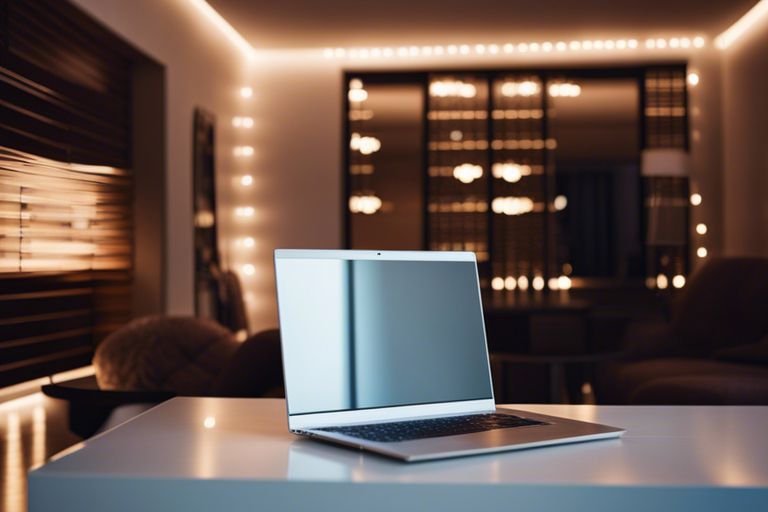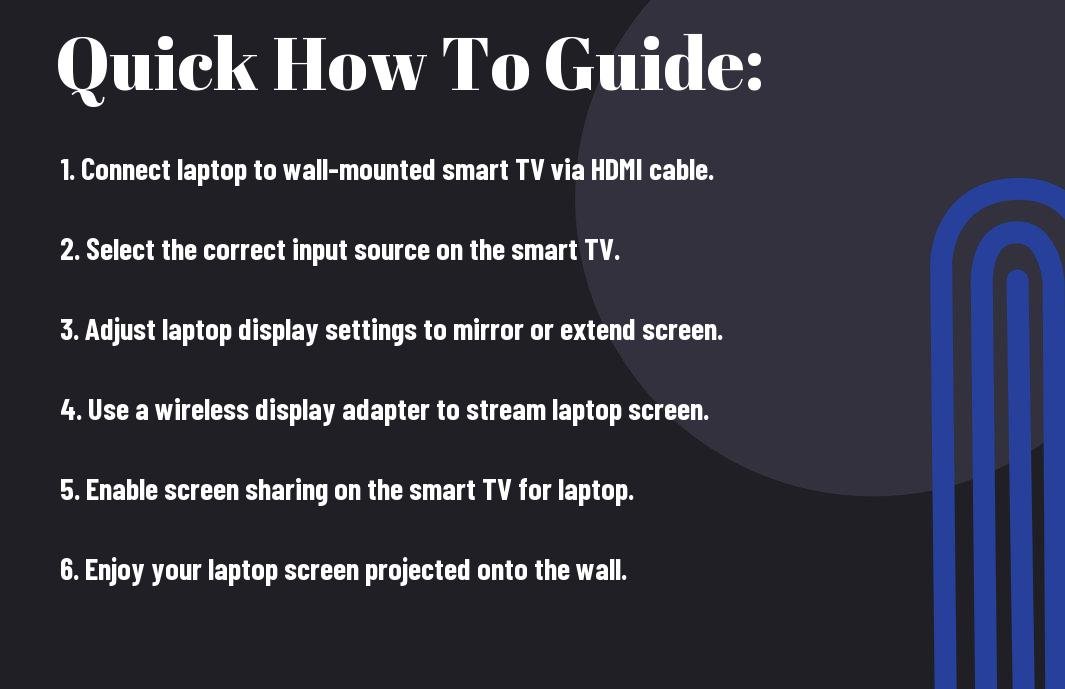How to Project Laptop Screen to Wall Without Projector – Innovative Viewing Solutions
- Home
- How to Project Laptop Screen to Wall Without Projector – Innovative Viewing Solutions

How to Project Laptop Screen to Wall Without Projector – Innovative Viewing Solutions
Perchance you ever find yourself in need of projecting your laptop screen onto a wall, but alas, a projector is nowhere to be found. Fear not, for I have discovered innovative viewing solutions that will allow you to achieve this feat without the need for a traditional projector. In this post, I will share with you the simple steps and ingenious techniques that will enable you to project your laptop screen to a wall with ease. Whether you need to give a presentation, share a video, or simply want to enjoy a larger viewing experience, these creative methods will revolutionize the way you interact with your laptop screen. Say goodbye to the constraints of a traditional projector and hello to a whole new world of possibilities.
Key Takeaways:
- Use a wireless display adapter: These small devices can be plugged into your laptop and will allow you to project your screen onto a wall without a projector.
- Try a smart TV or streaming device: Many smart TVs and streaming devices have the capability to mirror your laptop’s screen, providing another option for projecting onto a wall.
- Consider a portable projector: If you are willing to invest in a small, portable projector, this can also be a great solution for projecting your laptop screen onto a wall.
- Utilize a casting feature: Some laptops and TVs have the ability to cast your screen onto the TV, providing an alternative way to project your laptop screen without a physical projector.
- Adjust the laptop display settings: By adjusting the display settings on your laptop, you can optimize the screen for viewing on a wall, making it easier to project without a traditional projector.
Factors to consider before projecting laptop screen to wall
Your viewing experience and the success of projecting your laptop screen to the wall depends on various factors. Here are some key considerations to keep in mind before setting up your viewing system:
- Room lighting and wall color
- Distance and angle
- Surface texture and material
Assume that these factors can significantly impact the quality and clarity of the projected image.
Room lighting and wall color
When projecting your laptop screen onto a wall, it’s important to consider the room’s lighting and the color of the wall. Bright overhead lighting or light streaming in from windows can cause glare on the wall, affecting the visibility of the projected image. Additionally, the color of the wall can impact the brightness and clarity of the projection. Light-colored walls tend to reflect more light, providing better visibility, while dark-colored walls may absorb more light, resulting in a dimmer image. Consider choosing a wall with a neutral or light color for the best results.
Distance and angle
When setting up your projection, the distance between the laptop and the wall, as well as the angle at which the image is projected, play crucial roles in determining the overall quality of the viewing experience. It is important to position the laptop at an optimal distance from the wall to ensure a clear and sharp image. Additionally, the angle at which the image is projected can impact the visibility and distortion of the image. Finding the right balance between distance and angle is essential for an optimum viewing experience.
Surface texture and material
The texture and material of the wall can also influence the quality of the projected image. A smooth, flat surface is ideal for projecting a clear and sharp image. Rough or textured walls may cause distortion or unevenness in the projection. Additionally, the material of the wall can impact the brightness and clarity of the image. Reflective materials may provide better visibility, while porous materials may absorb light and result in a duller projection. Consider the surface texture and material of the wall when setting up your projection for the best results.
How-to tips for projecting laptop screen to wall
Obviously, not everyone has access to a projector at all times, but there are still ways to project your laptop screen onto a wall for a larger viewing experience. Here are a few tips to help you achieve this innovative viewing solution:
- Using a whiteboard or smooth surface
- Adjusting laptop display settings
- Utilizing a portable projector stand
This makes it possible to create a makeshift projector display with limited resources. It’s a great way to maximize your viewing experience without the need for an actual projector.
Using a whiteboard or smooth surface
When projecting your laptop screen onto a wall, the surface you use can make a big difference in the clarity and visibility of the image. A whiteboard or any other smooth, light-colored surface works best. I found that using a whiteboard provides a clear and crisp image, making it the perfect makeshift projector screen. Just make sure the surface is clean and free of any imperfections to ensure the best image quality.
Adjusting laptop display settings
Before projecting your laptop screen onto a wall, it’s important to adjust the display settings on your laptop to optimize the image. I recommend adjusting the screen resolution and display orientation to match the wall size and shape to avoid any distortion. Additionally, adjusting the brightness and contrast settings can greatly enhance the overall image quality, making for a better viewing experience.
Utilizing a portable projector stand
While you may not have a traditional projector, using a portable projector stand can help elevate your laptop to the perfect height for projecting onto a wall. This not only provides a steady and stable base for your laptop but also allows you to easily adjust the angle and distance to achieve the best image size and focus. It’s a simple yet effective solution for creating a makeshift projected display.
Innovative viewing solutions for projecting laptop screen to wall
For those who want to project their laptop screen to a wall without using a traditional projector, there are several innovative solutions available that can provide a similar viewing experience. Whether you want to use your smartphone as a projector, create a DIY projection screen, or utilize wireless streaming options, there are various ways to achieve this goal.
Using a smartphone as a projector
One innovative solution for projecting your laptop screen to a wall is to use your smartphone as a makeshift projector. By connecting your laptop to your smartphone via a video cable or wirelessly, you can use your smartphone’s screen as a display and project it onto the wall. While this method may not provide the same level of brightness or clarity as a traditional projector, it can be a convenient and portable option for on-the-go presentations or movie nights at home.
DIY projection screen alternatives
If you’re looking for an alternative to a traditional projector screen, you can create your own DIY projection screen using materials such as white bedsheets, blackout cloth, or projector screen paint. These materials can be easily mounted onto a wall or frame to create a makeshift projection surface. While the image quality may not be as sharp as a professional projector screen, it can be a cost-effective and customizable option for projecting your laptop screen to a larger surface.
Wireless streaming options
Another innovative solution for projecting your laptop screen to a wall is to utilize wireless streaming options such as screen mirroring devices, smart TVs, or streaming sticks. By connecting your laptop to these devices, you can wirelessly project your screen onto the wall without the need for cables or additional equipment. This can provide flexibility and convenience, allowing you to easily stream content from your laptop to a larger display without the hassle of physical connections.

Conclusion
So, there you have it – several innovative and effective ways to project your laptop screen onto a wall without the need for a traditional projector. Whether you opt for a smart TV, a streaming device, or a wireless HDMI adapter, you now have the tools to enjoy a large-scale viewing experience without the high cost and hassle of purchasing and setting up a projector. I hope this guide has provided you with the necessary information to make the most out of your viewing experience, and has offered you a solution that best fits your individual needs. As technology continues to advance, the possibilities for projecting your laptop screen in non-conventional ways will only increase, so always be on the lookout for new and improved methods. Happy viewing!
FAQ
Q: Can I project my laptop screen onto a wall without a projector?
A: Yes, there are innovative viewing solutions that allow you to project your laptop screen onto a wall without the need for a traditional projector.
Q: What are some innovative ways to project my laptop screen onto a wall?
A: You can use devices such as portable projectors, screen sharing apps, or smart TVs to project your laptop screen onto a wall without a projector.
Q: Are there specific requirements for projecting a laptop screen onto a wall without a projector?
A: Yes, you will need a compatible device, such as a portable projector or a smart TV, and a solid wall or projection surface to achieve the best results.
Q: Can I achieve high-quality resolution when projecting my laptop screen onto a wall without a projector?
A: With the right viewing solution and a high-quality display device, you can achieve impressive resolution and image quality when projecting your laptop screen onto a wall without a projector.
Q: What are the advantages of using innovative viewing solutions to project a laptop screen onto a wall without a projector?
A: Innovative viewing solutions offer flexibility, portability, and ease of use, allowing you to turn any wall into a display screen for presentations, movie nights, gaming, and more without the need for a bulky projector setup.
- Share
Mark Twain
Mark Twain stands at the helm of Create More Flow, infusing every sentence with the wisdom of his 15-year expeience through the seas of SEO and content creation. A former BBC Writer, Mark has a knack for weaving simplicity and clarity into a tapestry of engaging narratives. In the realm of content, he is both a guardian and a guide, helping words find their flow and stories find their homes in the hearts of readers. Mark's approach is grounded in the belief that the best content feels like a chat with an old friend: warm, inviting, and always memorable. Let Mark's expertise light up your website with content that's as friendly to Google as it is to your audience. Each word is chosen with care, each sentence crafted with skill - all to give your message the human touch that both readers and search engines love.
